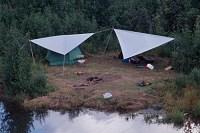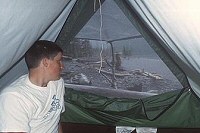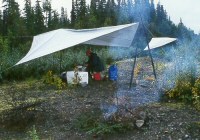Many books and articles have been written on survival and hypothermia but few have addressed the topic of how to keep you and your clothes dry while camping in the rain. For lack of a better term I call it “Water Discipline.” It’s a skill I have taught myself through trial and error. Bad Water Discipline can easily result in hypothermia but it usually results in people going home early or putting up with wet cold clothes and not enjoying themselves. Here are some tips on how to keep yourself dry.
Pack Smartly
 |
| Tarps
can really help with morale. It's imporant to keep them taunt and
angled to avoid pooling. |
In the coastal regions of Alaska it can rain for days at a time. Three or Four day showers are common. In such cases there is often very little chance to dry out your clothes. Your best bet is to try your best to keep your clothes dry and to replace wet clothes with dry. It’s easier said than done. If you are participate in activities such as kayaking, sailing, or hiking you are bound to soak your clothes from rain and sweat. Your best defense is to use one set of clothes/raingear for activities and another set for camping or fishing. On short trips I usually pack two sets of clothes for each day and two sets of raingear for the trip. Packing this way for a week long trip or longer is not practical and is unnecessary. The sun will come out eventually and you will have ample time to dry your clothes. A towel is handy for drying sleeping pads and the inside of raingear. Another invaluable item to carry is a tarp. I usually have two: one for my tent and one for the cooking area. If you take down a wet tent and put it up again the inside will be soaked. Using a tarp will prevent this. Get one big enough to keep your tent dry in the rain. I like 16x20ft heavy duty tarps. I like to hang two opposite ends up high with trees or 7-8 ft poles and then tie down the opposite corners to the ground or use 3ft poles. This will prevent rain from pooling up and breaking your tarp. Avoid putting a tarp under your tent if you can help it. Often, rain will hit the tarp and pool up underneath. If you must use a tarp because of the wet ground make double sure it’s tucked underneath the tent. Even a few inches sticking out will collect rainwater.
Act Smartly
 |
| Sometimes
it can rain for days. |
I’ve camped with others who go through clothes much faster than I. Why is this? They are not practicing good Water Discipline. Not putting on rain gear as soon as it starts raining, not putting on your jacket properly, dragging clothes through wet grass or dropping them in water, tripping, standing under dripping tarps etc. It’s just basic common sense really, but it does make a difference if you think the rain will last. If I’m just going out for the day I don’t worry much about it. Sometimes I prefer to hike in the rain and get wet especially if I’m climbing mountains or hunting. My body heat will keep me warm if I don’t stop and I can change into dry clothes when I return. Keeping your tent, packed clothes, and sleeping bad dry is crucial. I always use dry-bags and fasten them tightly. Always put your rainpants over your rubber boots. If not, you can easily fill your boots with rain water. Acting smartly also means not being paranoid. If it’s hot and sunny it’s ok to get wet or even wash your clothes. I often wade wet when floating rivers in hot weather.
The Myth of Breathable Raingear
Most breathable raingear will only keep you dry the first year you buy it. After it’s been stretched or worn it usually leaks. There is treatment fluid which helps but does not solve this dilemma. Even new breathable raingear can sometimes leak. I’m sure others disagree with me but my guess is they have not fished in a four day rain like I have. I personally don’t use it much anymore. Another thing I dislike is how hard it is to dry out breathable rain gear. It seems to take forever with all the layers and thick material. Simple non-breathable raingear like Helly Hansen Impertec is a single layer and dries quickly. Another thing I like about Helly Hansen is the inside collar cuff which prevents rain from running down the hood and into your jacket. What about breathable waders? Yes, they work fine the first year. I usually replace mine every one or two years.
It's a Material World
 |
| Don't
let the rain stop you from having fun. Be prepared. |
“Cotton Kills” is a common phrase. When it gets wet it sucks heat from your body. Cotton takes a long time to dry. Avoid cotton except on dry days. Wicking fabrics are best. They rely on capillary action and some water repelling coatings. I prefer polyester and wool. Polypropylene is ok but is old technology. Polyester is much better because it’s more durable and whicks better. I usually wear a polyester long underwear top with a polyester Polarfleece or Microfleece shirt and pants. I also like wool sweaters if it’s really cold or for boating/kayaking on windy rainy days. Wool is superior for survival because it keeps you warm even when wet. Smartwool socks are an excellent choice as well as wool glove liners. Wool does not dry out quickly so I usually only carry one wool sweater for really nasty weather. If I have to do allot of hiking in the rain I sometimes wear a Microfleece shirt without any long underwear underneath. Two layers is often too hot and fleece does a better job of wicking sweat then polyester long underwear. Here is a great article on wicking fabrics.
In the end it’s all about common sense and taking precautions. You’ll find it’s very easy to enjoy camping rain or shine if you come prepared and use proper Water Discipline. Remember something I learned in England..."There's no such thing as bad weather, only bad clothing."
Neil Moomey
[Home]